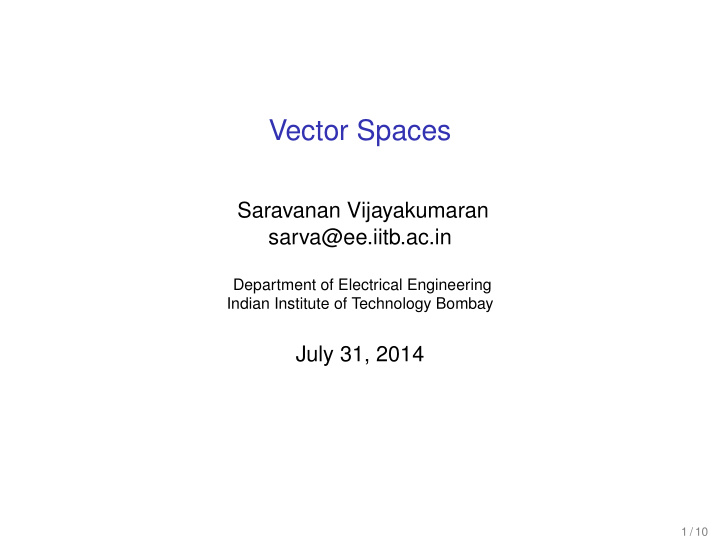



Vector Spaces Saravanan Vijayakumaran sarva@ee.iitb.ac.in Department of Electrical Engineering Indian Institute of Technology Bombay July 31, 2014 1 / 10
Vector Spaces Let V be a set with a binary operation + (addition) defined on it. Let F be a field. Let a multiplication operation, denoted by · , be defined between elements of F and V . The set V is called a vector space over F if • V is a commutative group under addition • For any a ∈ F and v ∈ V , a · v ∈ V • For any u , v ∈ V and a , b ∈ F a · ( u + v ) = a · u + b · v ( a + b ) · v = a · v + b · v • For any v ∈ V and a , b ∈ F ( ab ) · v = a · ( b · v ) • Let 1 be the unit element of F . For any v ∈ V , 1 · v = v 2 / 10
Binary Operations Definition A binary operation on a set A is a function from A × A to A Examples • Addition on the natural numbers N • Subtraction on the integers Z Definition A binary operation ⋆ on A is associative if for any a , b , c ∈ A a ⋆ ( b ⋆ c ) = ( a ⋆ b ) ⋆ c Definition A binary operation ⋆ on A is commutative if for any a , b ∈ A a ⋆ b = b ⋆ a 3 / 10
Groups Definition A set G with a binary operation ⋆ defined on it is called a group if • The operation ⋆ is associative • There exists an e ∈ G such that for any a ∈ G a ⋆ e = e ⋆ a = a . The element e is called the identity element of G • For every a ∈ G , there exists an element b ∈ G such that a ⋆ b = b ⋆ a = e Examples • Addition on the integers Z • Modulo m addition on Z m = { 0 , 1 , 2 , . . . , m − 1 } 4 / 10
Commutative Groups Definition A group G is called a commutative group if its binary operation is commutative. Commutative groups are also called abelian groups. Examples • Addition on the integers Z • Modulo m addition on Z m = { 0 , 1 , 2 , . . . , m − 1 } • Examples of non-abelian groups? 5 / 10
Fields Definition A set F together with two binary operations + and ∗ is a field if • F is a commutative group under + . The identity under + is called the zero element of F . • The set of non-zero elements of F is a commutative group under ∗ . The identity under ∗ is called the unit element of F . • For any a , b , c ∈ F a ∗ ( b + c ) = a ∗ b + a ∗ c Examples • R with usual addition and multiplication • Q with usual addition and multiplication • F 2 = { 0 , 1 } with mod 2 addition and usual multiplication 6 / 10
Vector Spaces Let V be a set with a binary operation + (addition) defined on it. Let F be a field. Let a multiplication operation, denoted by · , be defined between elements of F and V . The set V is called a vector space over F if • V is a commutative group under addition • For any a ∈ F and v ∈ V , a · v ∈ V • For any u , v ∈ V and a , b ∈ F a · ( u + v ) = a · u + b · v ( a + b ) · v = a · v + b · v • For any v ∈ V and a , b ∈ F ( ab ) · v = a · ( b · v ) • Let 1 be the unit element of F . For any v ∈ V , 1 · v = v 7 / 10
F n 2 is a vector space over F 2 • Addition in F n 2 is defined as component-wise addition modulo 2 • Multiplication between elements of F 2 and v ∈ F n 2 is defined as follows 0 · v = 0 1 · v = v • F n 2 is a commutative group under addition • All other properties are easy to verify 8 / 10
Subspaces Definition Let V be vector space over a field F . A subset S of V is called a subspace of V if it is also a vector space over F . Theorem Let S be a nonempty subset of a vector space V over a field F. Then S is a subspace of V if • For any u , v ∈ S, u + v also belongs to S. • For any a ∈ F and u ∈ S, a · u is also in S. 9 / 10
Questions? Takeaways? 10 / 10
Recommend
More recommend